List of United States Supreme Court cases, volume 40
| Supreme Court of the United States | |
|---|---|
 | |
| Established | March 4, 1789[1] |
| Location | Washington, D.C. |
| Coordinates | 38°53′26″N 77°00′16″W / 38.89056°N 77.00444°WCoordinates: 38°53′26″N 77°00′16″W / 38.89056°N 77.00444°W |
| Composition method | Presidential nomination with Senate confirmation |
| Authorized by | Constitution of the United States, Art. III, § 1 |
| Judge term length | life tenure, subject to impeachment and removal |
| Number of positions | 9 (by statute) |
| Website | supremecourt |
| Chief Justice of the United States | |
| Currently | John Roberts |
| Since | September 29, 2005 |
| This article is part of the series on the |
| Supreme Court of the United States |
|---|
 |
| The Court |
|
| Current membership |
|
| Lists of justices |
|
| Court functionaries |
|
|
| Constitutional law of the United States |
|---|
 |
| Overview |
|
| Principles |
|
| Government structure |
|
| Individual rights |
|
| Theory |
|
This is a list of the 30 cases reported in volume 40 (15 Pet.) of United States Reports, decided by the Supreme Court of the United States from January 1841 to March 1841.[2]
Nominative reports[]
In 1874, the U.S. government created the United States Reports, and retroactively numbered older privately-published case reports as part of the new series. As a result, cases appearing in volumes 1–90 of U.S. Reports have dual citation forms; one for the volume number of U.S. Reports, and one for the volume number of the reports named for the relevant reporter of decisions (these are called "nominative reports").
Richard Peters, Jr.[]
Starting with the 26th volume of U.S. Reports, the Reporter of Decisions of the Supreme Court of the United States was Richard Peters, Jr. Peters was Reporter of Decisions from 1828 to 1843, covering volumes 26 through 41 of United States Reports which correspond to volumes 1 through 16 of his Peter's Reports. As such, the dual form of citation to, for example, Levy v. Fitzpatrick is 40 U.S. (15 Pet.) 167 (1841).
Justices of the Supreme Court at the time of 40 U.S. (15 Pet.)[]
The Supreme Court is established by Article III, Section 1 of the Constitution of the United States, which says: "The judicial Power of the United States, shall be vested in one supreme Court . . .". The size of the Court is not specified; the Constitution leaves it to Congress to set the number of justices. Under the Judiciary Act of 1789 Congress originally fixed the number of justices at six (one chief justice and five associate justices).[3] Since 1789 Congress has varied the size of the Court from six to seven, nine, ten, and back to nine justices (always including one chief justice). When the cases in 40 U.S. (15 Pet.) were decided the Court comprised nine justices at the start of the 1841 term, but only eight when it adjourned in March 1841; Justice Philip P. Barbour had died in February 1841.[4]
| Portrait | Justice | Office | Home State | Succeeded | Date confirmed by the Senate (Vote) |
Tenure on Supreme Court |
|---|---|---|---|---|---|---|
 |
Roger B. Taney | Chief Justice | Maryland | John Marshall | March 15, 1836 (29–15) |
March 28, 1836 – October 12, 1864 (Died) |
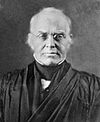
|
Joseph Story |
Associate Justice | Massachusetts | William Cushing | November 18, 1811 (Acclamation) |
February 3, 1812 – September 10, 1845 (Died) |
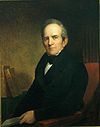 |
Smith Thompson | Associate Justice | New York | Henry Brockholst Livingston | December 9, 1823 (Acclamation) |
September 1, 1823 – December 18, 1843 (Died) |
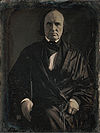 |
John McLean | Associate Justice | Ohio | Robert Trimble | March 7, 1829 (Acclamation) |
January 11, 1830 – April 4, 1861 (Died) |
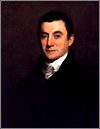 |
Henry Baldwin | Associate Justice | Pennsylvania | Bushrod Washington | January 6, 1830 (41–2) |
January 18, 1830 – April 21, 1844 (Died) |
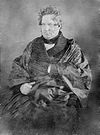 |
James Moore Wayne | Associate Justice | Georgia | William Johnson | January 9, 1835 (Acclamation) |
January 14, 1835 – July 5, 1867 (Died) |
 |
Philip P. Barbour | Associate Justice |
Virginia |
Gabriel Duvall | March 15, 1836 (30–11) |
May 12, 1836 – February 25, 1841 (Died) |
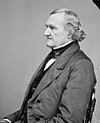 |
John Catron | Associate Justice | Tennessee | newly-created seat | March 8, 1837 (28–15) |
May 1, 1837 – May 30, 1865 (Died) |
 |
John McKinley | Associate Justice | Alabama | newly-created seat | September 25, 1837 (Acclamation) |
January 9, 1838 – July 19, 1852 (Died) |
Notable Case in 40 U.S. (15 Pet.)[]

The Schooner Amistad[]
The Schooner Amistad, 40 U.S. (15 Pet.) 518 (1841), resulted from the rebellion of kidnapped Africans on board the Spanish schooner La Amistad in 1839. It was an unusual freedom suit that involved international issues and parties as well as U.S. law. The lower courts ruled that the captives had acted as free men when they fought to escape their illegal confinement and were entitled to take whatever measures were necessary to secure their freedom, including the use of force. Under international and Southern sectional pressure, American President Martin Van Buren ordered the case appealed to the US Supreme Court, which affirmed the lower court ruling and authorized release of the captives.
Citation style[]
Under the Judiciary Act of 1789 the federal court structure at the time comprised District Courts, which had general trial jurisdiction; Circuit Courts, which had mixed trial and appellate (from the US District Courts) jurisdiction; and the United States Supreme Court, which had appellate jurisdiction over the federal District and Circuit courts—and for certain issues over state courts. The Supreme Court also had limited original jurisdiction (i.e., in which cases could be filed directly with the Supreme Court without first having been heard by a lower federal or state court). There were one or more federal District Courts and/or Circuit Courts in each state, territory, or other geographical region.
Bluebook citation style is used for case names, citations, and jurisdictions.
- "C.C.D." = United States Circuit Court for the District of . . .
- e.g.,"C.C.D.N.J." = United States Circuit Court for the District of New Jersey
- "D." = United States District Court for the District of . . .
- e.g.,"D. Mass." = United States District Court for the District of Massachusetts
- "E." = Eastern; "M." = Middle; "N." = Northern; "S." = Southern; "W." = Western
- e.g.,"C.C.S.D.N.Y." = United States Circuit Court for the Southern District of New York
- e.g.,"M.D. Ala." = United States District Court for the Middle District of Alabama
- "Adm." = Admiralty Court (a federal court)
- "Ct. Cl." = United States Court of Claims
- "Ct. Com. Pl." = Court of Common Pleas (a state court)
- The abbreviation of a state's name alone indicates the highest appellate court in that state's judiciary at the time.
- e.g.,"Pa." = Supreme Court of Pennsylvania
- e.g.,"Me." = Supreme Judicial Court of Maine
List of cases in 40 U.S. (15 Pet.)[]
| Case Name | Page & year | Opinion of the Court | Concurring opinion(s) | Dissenting opinion(s) | Lower court | Disposition of case |
|---|---|---|---|---|---|---|
| Vaughan v. Northup | 1 (1841) | Story | none | none | C.C.D.C. | affirmed |
| Gaines v. Relf | 9 (1841) | Thompson | none | none | C.C.E.D. La. | remanded to divided lower court |
| Coons' Lessee v. Gallaher | 18 (1841) | Taney | none | none | Ohio | dismissed for want of jurisdiction |
| Mayburry v. Brien | 21 (1841) | McLean | none | none | C.C.D. Md. | affirmed |
| The Schooner North Carolina | 40 (1841) | Taney | none | none | Ct. App. Terr. Fla. | reversed |
| Mitchel v. United States | 52 (1841) | Wayne | none | none | Fla. Super. Ct. | affirmed |
| Brush v. Ware | 93 (1841) | McLean | none | none | C.C.D. Ohio | affirmed |
| Gorman v. Lenox's Ex'rs | 115 (1841) | McLean | none | none | C.C.D.C. | affirmed |
| Ex parte Crenshaw | 119 (1841) | Taney | none | none | C.C.S.D. Ala. | prior decree nullified |
| Smith v. Clapp | 125 (1841) | McKinley | none | none | C.C.S.D. Ala. | affirmed |
| United States v. Rodman | 130 (1841) | Wayne | none | none | Fla. Super. Ct. | affirmed |
| United States v. Dickson | 141 (1841) | Story | none | none | C.C.S.D. Miss. | affirmed |
| Levy v. Fitzpatrick | 167 (1841) | McKinley | none | none | C.C.E.D. La. | dismissed |
| United States v. Forbes' Heirs | 173 (1841) | Catron | none | none | Fla. Super. Ct. | reversed |
| United States v. Boyd | 187 (1841) | Catron | none | none | C.C.S.D. Miss. | reversed |
| Amis v. Pearle | 211 (1841) | Story | none | none | not indicated | dismissed |
| Lea v. Kelly | 213 (1841) | Taney | none | none | C.C.S.D. Ala. | dismissed |
| Buyck v. United States | 215 (1841) | Wayne | none | none | Fla. Super. Ct. | affirmed |
| United States v. Delespins's Heirs | 226 (1841) | Wayne | none | none | Fla. Super. Ct. | affirmed |
| Rhode Island v. Massachusetts | 233 (1841) | Taney | none | none | original jurisdiction | defendant ordered to answer |
| O'Hara v. United States | 275 (1841) | Wayne | none | none | Fla. Super. Ct. | affirmed |
| Gwin v. Breedlove | 284 (1841) | Taney | none | none | C.C.S.D. Miss. | prior decree nullified |
| Young v. Smith | 287 (1841) | Story | none | none | C.C.S.D. Ala. | dismissed |
| United States v. Linn | 290 (1841) | Thompson | none | none | C.C.D. Ill. | remanded to divided lower court |
| Gratiot v. United States | 336 (1841) | Story | none | none | C.C.D. Mo. | reversed |
| United States v. Bank of the Metropolis | 377 (1841) | Wayne | none | none | C.C.D.C. | affirmed |
| United States v. Fitzgerald | 407 (1841) | McKinley | none | none | C.C.E.D. La. | affirmed |
| Minis v. United States | 423 (1841) | Story | none | none | C.C.D. Ga. | affirmed |
| Groves v. Slaughter | 449 (1841) | Thompson | McLean, Taney | none | C.C.E.D. La. | affirmed |
| The Schooner Amistad | 518 (1841) | Story | none | none | C.C.D. Conn. | affirmed (part); reversed (part) |
Notes and references[]
- ^ Lawson, Gary; Seidman, Guy (2001). "When Did the Constitution Become Law?". Notre Dame Law Review. 77: 1–37.
- ^ Anne Ashmore, DATES OF SUPREME COURT DECISIONS AND ARGUMENTS, Library, Supreme Court of the United States, 26 December 2018.
- ^ "Supreme Court Research Guide". Georgetown Law Library. Retrieved April 7, 2021.
- ^ On February 26, 1841, outgoing President Martin Van Buren, a Democrat, nominated Peter Vivian Daniel to serve as an Associate Justice of the Supreme Court of the United States, to the seat vacated at Barbour's death the prior month. As Daniel's nomination to the Court came during the last week of the president's term, with his elected successor William Henry Harrison of the Whig party due to take office on March 4, 1841, Whigs opposed confirmation in the Senate. Nonetheless, the Senate confirmed Daniel by a wide margin (25–5) on March 2, 1841, and he received his commission the following day. His actual service on the Supreme Court, however, began on January 10, 1842.
See also[]
- Certificate of division
External links[]
- [1] Case reports in volume 40 (15 Pet.) from Court Listener
- [2] Case reports in volume 40 (15 Pet.) from the Caselaw Access Project of Harvard Law School
- [3] Case reports in volume 40 (15 Pet.) from Google Scholar
- [4] Case reports in volume 40 (15 Pet.) of Justia
- [5] Case reports in volume 40 (15 Pet.) from Open Jurist
- Website of the United States Supreme Court
- United States Courts website about the Supreme Court
- National Archives, Records of the Supreme Court of the United States
- American Bar Association, How Does the Supreme Court Work?
- The Supreme Court Historical Society
- Lists of United States Supreme Court cases by volume
- Lists of United States Supreme Court cases
- United States Supreme Court cases
- United States case law lists
- 1841 in United States case law

